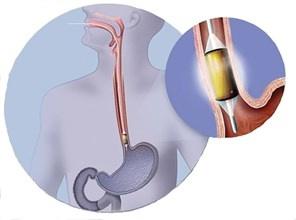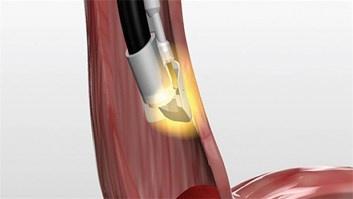Radio Frequency Ablation (RFA)
What is the treatment option using the RFA technology?
“Ablation” is a technique where tissue is heated until it is no longer viable or alive. Physicians have used various forms of ablation for nearly a century to treat a number of cancerous and precancerous conditions, as well as to control bleeding. The RFA technology is a very specific type of ablation, in which heat energy is delivered in a precise and highly controlled manner.

Barretts Oesophagus tissue is very thin and is therefore a good candidate for removal with ablative energy. Delivery of ablative energy via an RFA catheter is therefore capable of achieving complete removal of the diseased tissue without damage to the normal underlying structures.
Clinical studies have demonstrated dysplastic (premalignant) Barrett’s tissue can be completely eliminated with the RFA technology in 94% patients, and all Barrett’s tissue in 85%.
What happens during treatment with the RFA technology?
Ablation therapy is performed in conjunction with upper endoscopy (see Gastroscopy tab). The treatment is performed in an outpatient setting and no incisions are involved. The RFA technology consists of a number of different devices: the RFA 360, 90, 60 and Through-The-Scope ablation catheters. The RFA 360 ablation catheter is capable of treating larger areas of circumferential Barretts Oesophagus, while the other ablation catheters are used to treat smaller areas.
What to expect after treatment?
Patients may experience some chest discomfort and difficulty swallowing for several days after the procedure, both of which are managed with medications provided by the physician. In clinical trials, these symptoms typically resolved within 3-4 days. Patients are provided with anti-acid medications to promote healing of the treated oesophagus and replacement of the diseased Barrett’s tissue with a normal, healthy oesophageal lining.
Immediate serious complications of significant bleeding may occur in one in a hundred treatments and perforation of the oesophagus less than 1 in 200. Healing of the treated Barrett’s may result in a stricture in ~ 10% of cases, which can be treated with endoscopic dilatation.
A follow-up appointment is scheduled within 8-10 weeks to assess the response to treatment and if there remains any residual Barrett’s tissue, additional treatments may be given. The average numbers of RFA treatments required is between 2 and 3.

How is GORD managed after a successful ablation?
Successful elimination of the Barretts Oesophagus tissue does not cure pre-existing GORD or the associated symptoms. The physician will guide the patient regarding long-term GORD therapy.
Ask your physician about treating your Barretts Oesophagus with the Radio Frequency Ablation technology.
Dr Russell Walmsley has specialist training in RFA therapy. To arrange an appointment to discuss this with him contact his rooms at This email address is being protected from spambots. You need JavaScript enabled to view it. or to arrange a gastroscopy here at Waitemata Endoscopy Limited contact us .





